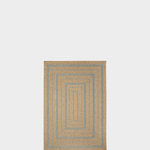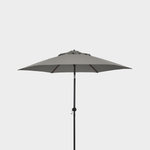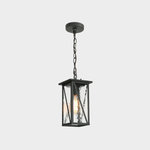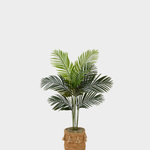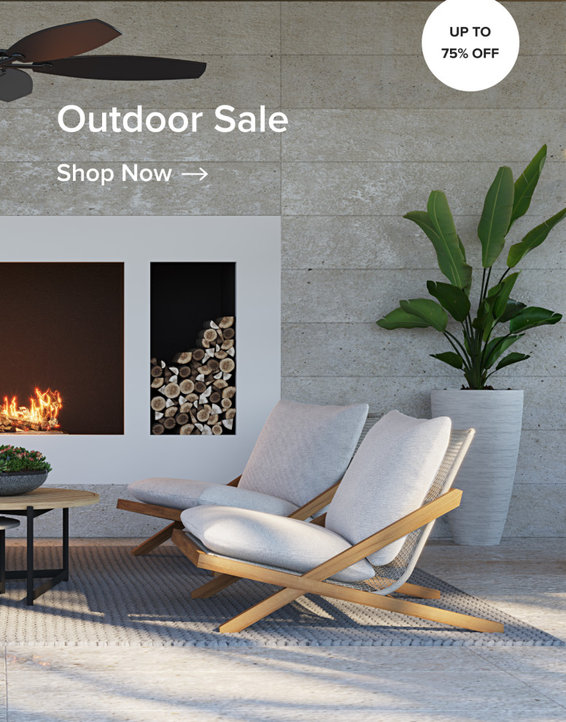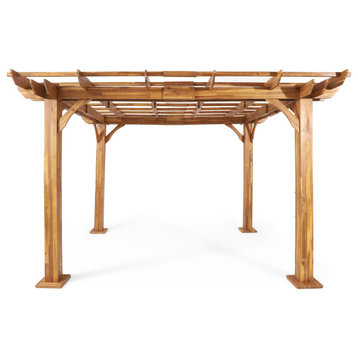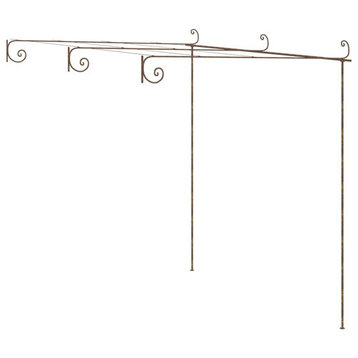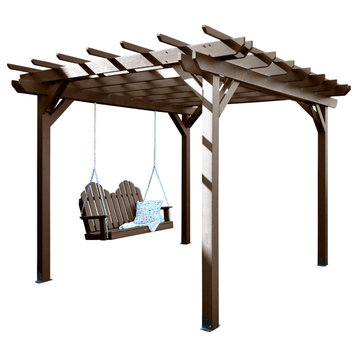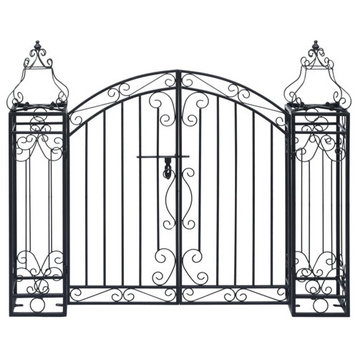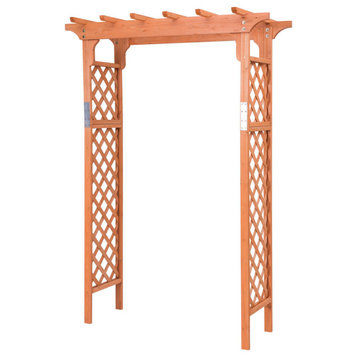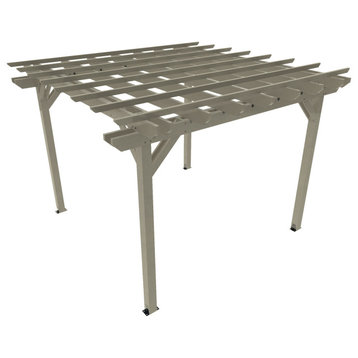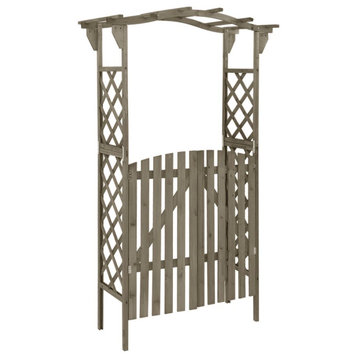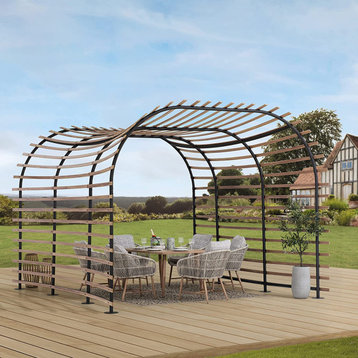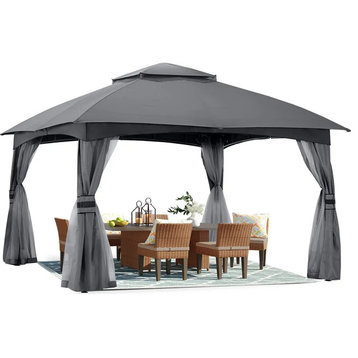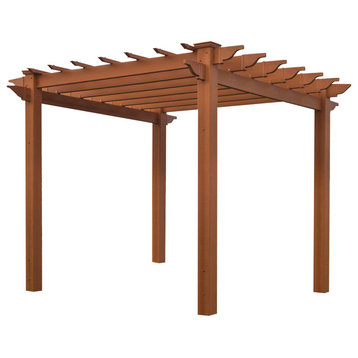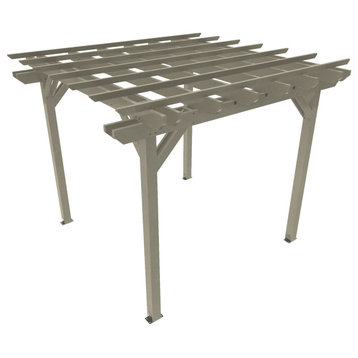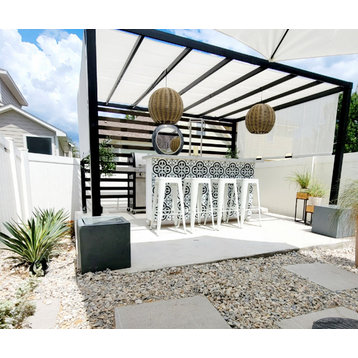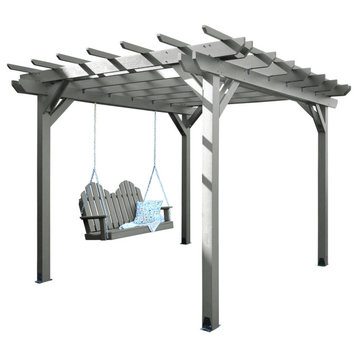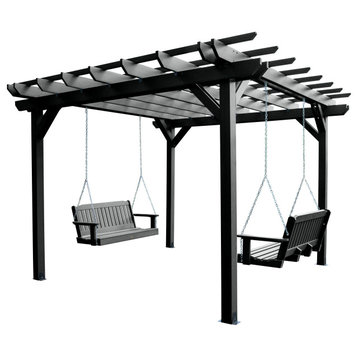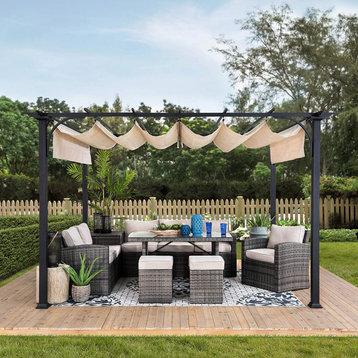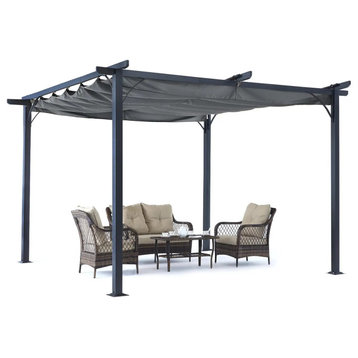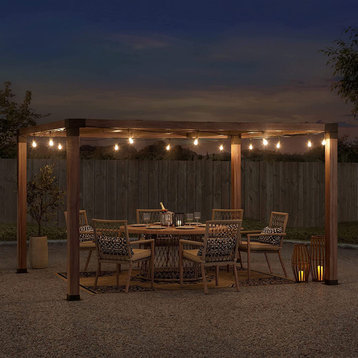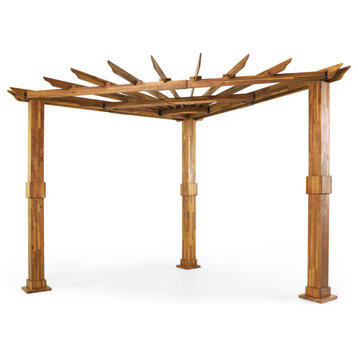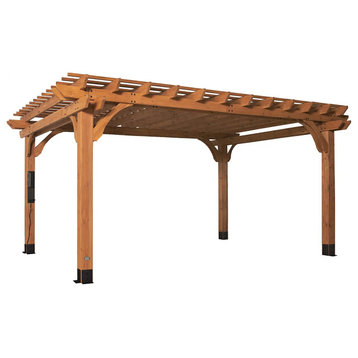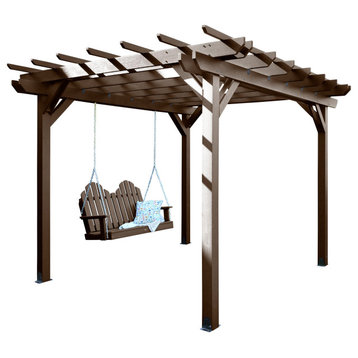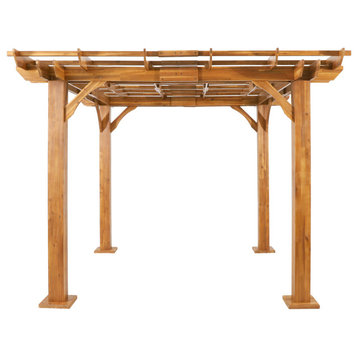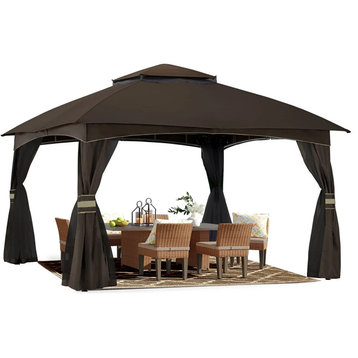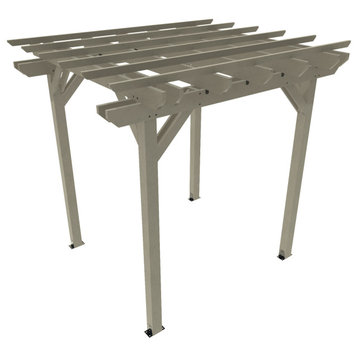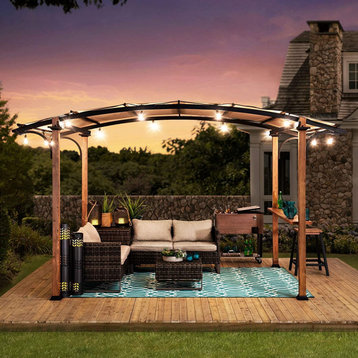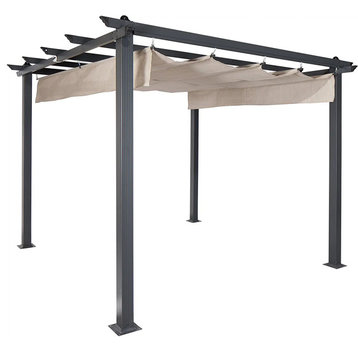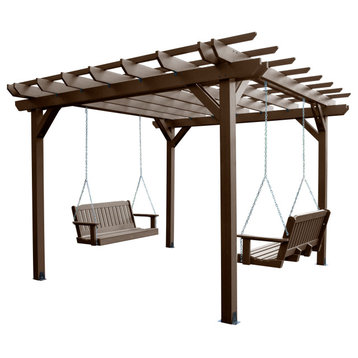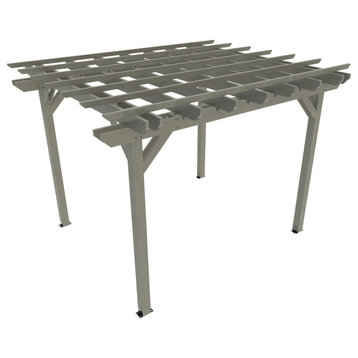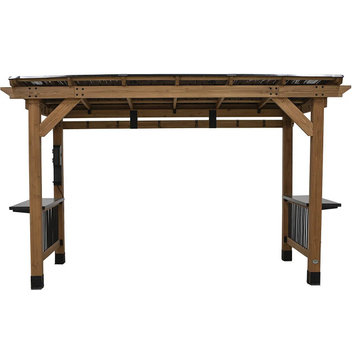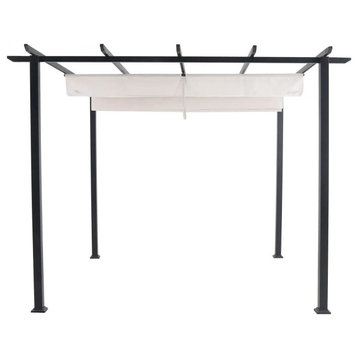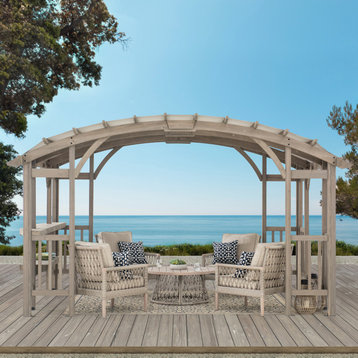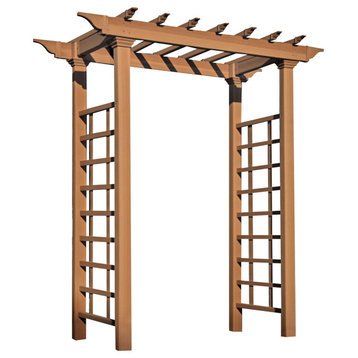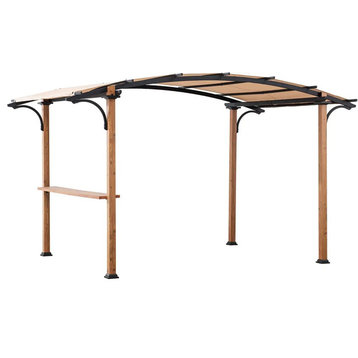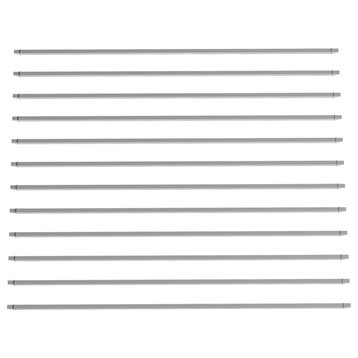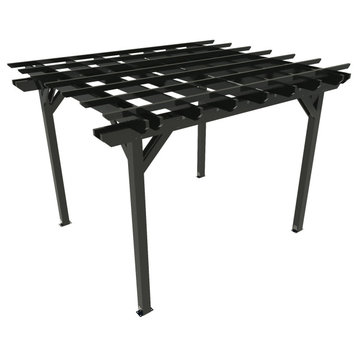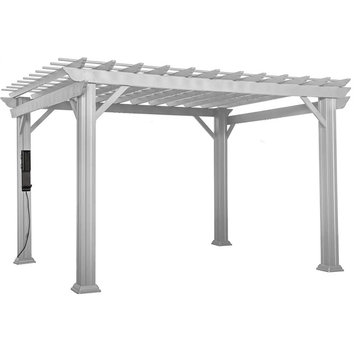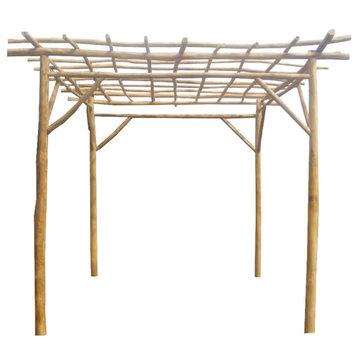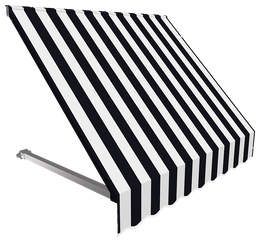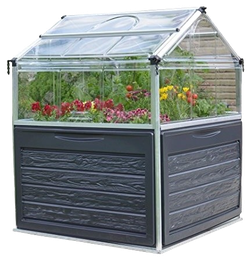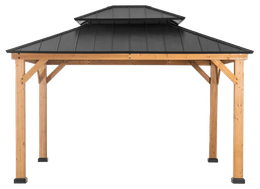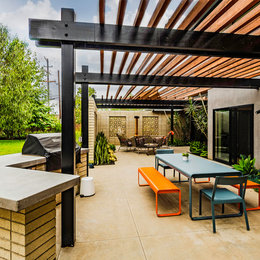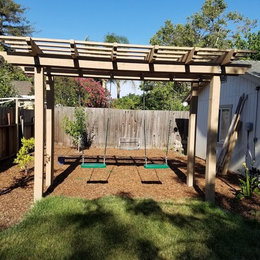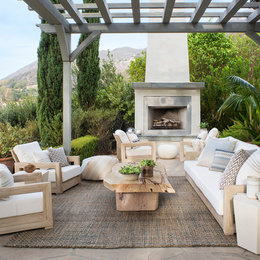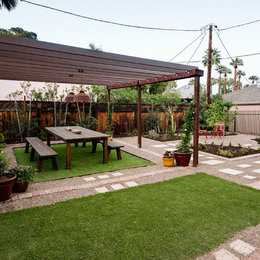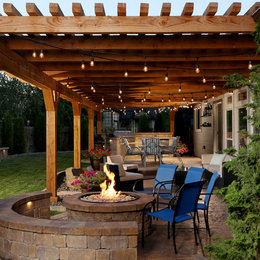FREE shipping on orders over $49!* Details
Pergolas
57 Results
Sort by:
Price
57 Results
Evatt Outdoor 12'x10' Acacia Wood Pergola, Teakby GDFStudio
$1,432
Free Shipping
Transform your outdoor space into a personal oasis filled with cool shade and homey style. Beautifully crafted from rich acacia wood, our delightful pergola showcases a solid and sturdy framework that not only upgrades your space with a dash of rustic charm but also offers a multitude of functions. The classic design and open rafter allow you to place this accessory in any space of your yard or patio, providing both refreshing shade and privacy for you and your family to enjoy.
- CLASSIC DESIGN: This pergola offers a traditional, four-post design topped by an open rafter for plenty of shade. This adds an elegant ambiance to your outdoor space, making this perfect for outdoor gatherings and barbeques.
- MULTI-PURPOSE: Whether this is used as shade, for privacy purposes, purely for decorative appeal, or all three, this piece can be used in a multitude of ways. Our pergola is designed to match any outdoor space, including your poolside, garden, or deck.
- ACACIA WOOD: Made with acacia wood that brings a sleek and exotic look to your space, this durable hardwood naturally withstands outdoor elements and will not darken over time. Acacia wood is perfect as a solid, heavy frame that resists wear and tear.
- DIMENSIONS: Choose an accessory that is the perfect size for you and your furniture. This pergola is 144.00" W x 120.00" D x 93.00" H. You will love how much your space can transform with the simple addition of this charming pergola.
- ASSEMBLY REQUIRED: Some assembly is required for this pergola. All of the instructions and tools needed for assembly are included.
- Includes: One (1) Pergola
- Material: Acacia Wood
- Finish: Teak
- Assembly Required
- Dimensions: 120.00 inches deep x 144.00 inches wide x 93.00 inches high
vidaXL Garden Pergola Antique Brown 9.8' Iron Outdoor Patio Pergola Arborby vidaXL LLC
$160
Free Shipping
This garden pergola is a perfect choice for roses and climbing plants in your garden, patio or terrace. Constructed from wrought iron frame, the pergola is strong and durable enough to support climbing plants. The pretty ornaments give the garden arbor a romantic feel and add a great elegance to your porch or backyard. This lean-to pergola provides an ideal shade shelter for you in the summer when covering with plants. Additionally, it is also a lovely arbor for climbing vines like ivy, clematis, wisteria, grape vines, flowers, etc.
- Color: Antique brown
- Material: Wrought iron
- Dimensions: 9.8' x 9.8' x 7.2'/8.2' (W x D x H)
- Assembly required: Yes
Bodhi Pergola, 10x10 and Classic Westport Swing Set 4'by highwood(9)
Awaken your yard with this outdoor oasis! The Bodhi Pergola creates an earthy feel with its open and clean-lined support beams which meet to provide natural shade. This is a structure that will withstand even the harshest climates to provide an airy and sturdy escape year-after-year. The pergola is as easy on the eyes as it is on the body meaning no sanding or staining required EVER. The Westport Porch swing brings carefree relaxation and seating to the arrangement.
A mounting kit and free zinc-plated steel chain are supplied so swing is ready to hang to the pergola. Swing contains (2) 7ft chains and (2) 2ft chains. Total height from end of chain attached at the pergola to the top of seat is 80 . Additional chain can be purchased upon request.
The proprietary Highwood high-grade poly lumber used in this product offers the most realistic look of natural wood WITHOUT the headaches of maintaining or replacing every few seasons. Simply wash your highwood furniture to remove any dirt or grime.
Explore the entire line of highwood products to coordinate other beautiful, durable products that will make your outdoor living space the envy of the neighborhood. Still not sure? Request a free product swatch so you can view the color and composition in person.
This product is assembled with 304-grade stainless steel hardware and comes with the assurance of a manufacturer's 12-year residential limited warranty. Assembly is required (see assembly video and guide). Includes mounting brackets. If desired, customer can supply anchors suitable for the installation surface. The highwood Bodhi Pergola is designed to only support highwood brand swings and requires that the swings be attached with approved brackets (provided by Highwood USA). Use of any other swing OR bracket voids the warranty on this product. Please note, this is a larger item that ships LTL and the boxed components are delivered on a pallet.
$4,757
Free Shipping
Sponsored- 100% Made in the USA - backed by US warranty and support
- Weatherproof - will not crack, peel, or rot when exposed to the elements
- No sanding, staining, or painting - yet it looks like real wood
- Durable material - assembled with 304-grade stainless steel hardware
- Assembly required (see assembly video and guide)
- Welcome to highwood. Welcome to relaxation.
Awaken your yard with this outdoor oasis! The Bodhi Pergola creates an earthy feel with its open and clean-lined support beams which meet to provide natural shade. This is a structure that will withstand even the harshest climates to provide an airy and sturdy escape year-after-year. The pergola is as easy on the eyes as it is on the body meaning no sanding or staining required EVER. The Westport Porch swing brings carefree relaxation and seating to the arrangement.
A mounting kit and free zinc-plated steel chain are supplied so swing is ready to hang to the pergola. Swing contains (2) 7ft chains and (2) 2ft chains. Total height from end of chain attached at the pergola to the top of seat is 80 . Additional chain can be purchased upon request.
The proprietary Highwood high-grade poly lumber used in this product offers the most realistic look of natural wood WITHOUT the headaches of maintaining or replacing every few seasons. Simply wash your highwood furniture to remove any dirt or grime.
Explore the entire line of highwood products to coordinate other beautiful, durable products that will make your outdoor living space the envy of the neighborhood. Still not sure? Request a free product swatch so you can view the color and composition in person.
This product is assembled with 304-grade stainless steel hardware and comes with the assurance of a manufacturer's 12-year residential limited warranty. Assembly is required (see assembly video and guide). Includes mounting brackets. If desired, customer can supply anchors suitable for the installation surface. The highwood Bodhi Pergola is designed to only support highwood brand swings and requires that the swings be attached with approved brackets (provided by Highwood USA). Use of any other swing OR bracket voids the warranty on this product. Please note, this is a larger item that ships LTL and the boxed components are delivered on a pallet.
vidaXL Garden Gate Ornamental Garden Archway Driveway Entrance Gate Wrought Ironby vidaXL LLC
$182
Free Shipping
Our ornamental garden gate is designed to make a stylish, practical entryway to seclude your garden from the outside world. This garden gate is perfect in workmanship since it is manufactured from wrought iron which goes through heating, bending, shaping and twisting till the desired shape. It also comes with a bolt hinge for quick lock and mounting posts for easy installation. This gate is an excellent combination of strength and affordable price!
- Color: Black
- Material: Wrought iron
- Dimensions: 48" x 8.1" x 39.4" (W x D x H)
- Assembly required: Yes
Costway Arbor Over 7FT High Wooden Garden Arch Trellis Pergola Outdoor Plantby Goplus Corp
$161
Free Shipping
This our elegant garden arbor ,featuring durable fir wood construction ,is very sturdy and stable .Perfect for the pathway, pool, or garden entrance, Lattice side panels on the arbor act as the perfect support for your choice of climbing plants. The subtly classic design of the garden arbor fits perfectly amidst landscape themes both classic and modern.
Attractive archway, add grace and prominence to any outdoor venue
A great arbor for the pathway, pool, or garden entrance, the subtly classic design of the garden arbor fits perfectly amidst landscape themes both classic and modern.
The modern stylish arbor improve weatherability and beauty of the wood
Assembly requirement
Feature
- Made from durable fir wood construction, sturdy construction ensure years of use
Attractive archway, add grace and prominence to any outdoor venue
A great arbor for the pathway, pool, or garden entrance, the subtly classic design of the garden arbor fits perfectly amidst landscape themes both classic and modern.
The modern stylish arbor improve weatherability and beauty of the wood
Assembly requirement
Specification
- Color:yellow
- Material:fir wood
- Weight:34 lbs
- Product size :49''X32''X88''(L x W x H)
Package includes:
- 1 X Wooden Arbor
The Sequoia Professional Commercial Grade Ridgecrest 12x12 Pergola, Coastal Teakby Sequioa
SALE
$6,700$11,924
Free Shipping
SponsoredOur unique, proprietary synthetic wood has been used extensively in world-famous, high-traffic environments since 2003. A favorite wood-alternative for engineers at major theme parks, its realism, natural beauty and ease of maintenance means that it has seen use in projects ranging from custom furniture to fencing, flooring, wall covering and trash receptacles.
This product comes with the assurance of a manufacturer's 3-yr commercial/20-yr residential use limited warranty. Assembly is required (see assembly video and guide) and assembled dimensions are 103"W x 98"H x 103"D (390lbs). Includes mounting brackets. If desired, the customer can supply anchors suitable for the installation surface. Please note, this is a larger item that ships LTL and the boxed components are delivered on a pallet.
Available colors include Black, Weathered Acorn, and Coastal Teak. Still not sure? Request a free product swatch so you can view the color and composition in person.
Since 2003, we have been a world leader in the production of the highest quality semi-structural synthetic wood for outdoor use. That ability was quickly tapped by some of the biggest names in the Theme Park business and now our material can be found from Florida to Tokyo in furniture & building projects. It is also the most commonly used material on hot-tubs/spas for more than a decade the biggest names in the industry use our material to build their cabinets.
Fast forward to today and we now build our own residential furniture brands, delivering the same unrivaled natural-wood beauty with the luxury of no-fuss ownership.
Our material is still used in custom outdoor commercial projects around the world. The natural wood-like tones, grained texture, and durability make it an obvious replacement to wood and unlike other plastic wood products, it does not have a waxy look or feel. This record of success in commercial environments and in manufacturing high-quality outdoor furniture led to the launch of Sequoia Professional outdoor living products designed to be beautiful, functional and durable.
- We therefore proudly introduce "Sequoia Professional", our contract grade outdoor living brand...designed for high-traffic areas.
- Backed by a 3-yr commercial/20-yr residential use limited warranty
- The most beautiful real-wood aesthetics with easy-care maintenance
- Designed for beauty, built for heavy use
- Green conscious production uses recycled content
- 100% made in the USA we believe in quality and integrity
- Assembly required
This product comes with the assurance of a manufacturer's 3-yr commercial/20-yr residential use limited warranty. Assembly is required (see assembly video and guide) and assembled dimensions are 103"W x 98"H x 103"D (390lbs). Includes mounting brackets. If desired, the customer can supply anchors suitable for the installation surface. Please note, this is a larger item that ships LTL and the boxed components are delivered on a pallet.
Available colors include Black, Weathered Acorn, and Coastal Teak. Still not sure? Request a free product swatch so you can view the color and composition in person.
Since 2003, we have been a world leader in the production of the highest quality semi-structural synthetic wood for outdoor use. That ability was quickly tapped by some of the biggest names in the Theme Park business and now our material can be found from Florida to Tokyo in furniture & building projects. It is also the most commonly used material on hot-tubs/spas for more than a decade the biggest names in the industry use our material to build their cabinets.
Fast forward to today and we now build our own residential furniture brands, delivering the same unrivaled natural-wood beauty with the luxury of no-fuss ownership.
Our material is still used in custom outdoor commercial projects around the world. The natural wood-like tones, grained texture, and durability make it an obvious replacement to wood and unlike other plastic wood products, it does not have a waxy look or feel. This record of success in commercial environments and in manufacturing high-quality outdoor furniture led to the launch of Sequoia Professional outdoor living products designed to be beautiful, functional and durable.
vidaXL Pergola Outdoor Pergola Garden Arch with Gate for Deck Gray Solid Fir, Gray, 1 Pcsby vidaXL LLC(2)
$185
Free Shipping
This versatile wooden pergola with gate is meant to be a decorative addition to your garden or any other outdoor space. Made of solid firwood and solid pine wood, this garden arch is weather-resistant and durable. The beautiful arch is wonderful as an entrance, passage or for decorating your garden path. When the vines climb on, you will not be able to take your eyes off this beautiful pergola.
- Color: Gray
- Material: Solid firwood, solid pine wood with water lacquer finish
- Dimensions: 45.7" x 15.7" x 80.3" (L x W x H)
- Assembly required: Yes
Sunjoy SummerCove 14'x12' Racewood Metal Pergolaby Sunjoy
$3,054
Free Shipping
Do you need an elegant outdoor area to entertain friends and family and want to make a statement? If you would love to move the party outside but do not have a comfortable place to gather the 14'x12'. Racewood metal pergola by SummerCove is the perfect solution. Made with a durable, powder-coated rust-resistant steel frame and a finish to appear as natural wood, this attractive modern style complements most home designs. With straightforward, easy-to-follow instructions, you will be enjoying your new outdoor space in no time.
- Dark brown powder-coated rust-resistant steel frame
- Natural wood grain appearance on powder-coated rust-resistant steel
- Easy illustrative assembly instructions with an experienced customer service team at the ready for any questions that may arise
- Professional Assembly Services for an additional fee are available. Contact Sunjoy (Sunjoy optional) Customer Service for more information
Patio Pergola, Metal Frame, Arch Dome Top and Rip Lock Fabric Cover, Dark Grayby Decor Love
$669
Free Shipping
DURABLE CONSTRUCTION- The frame is made of high-grade engineered steel, sturdy, and not easy to rust. The diameter of the pole is about 50mm(2''), gross weight is about 81.4LBS, giving you safe surroundings.
Large Accommodation Room- 120 square feet of coverage is roomy for 8-10 people to entertain and 2 three-seat sofas + 2 single-seat sofas to set. Please measure the size of your platform and furniture according to the picture before buying.
Perfect Dome Top- Designed with Arc Shape and Rip-lock fabric. It's stable and strong enough based on eight supporting steel tubes inside, and the joint of the beams is designed with a triangular structure to enhance stability. A vented roof can reduce wind stress on the top during windy days, this gazebo can withstand various weather conditions.
Superior Fabric- The gazebo canopy is made of Rip-Lock material for long-time use. All fabrics are PU coated and all stitching lines are sealed and have a good tear-resistant function.
Netting Walls& Pole Coverings- Netting Walls with zipper provide you with a comfortable environment and keep your privacy. Pole Coverings protect legs from sun and rain and make the gazebo more elegant. (Pole Coverings only instead of the curtain panel, kindly note)
Large Accommodation Room- 120 square feet of coverage is roomy for 8-10 people to entertain and 2 three-seat sofas + 2 single-seat sofas to set. Please measure the size of your platform and furniture according to the picture before buying.
Perfect Dome Top- Designed with Arc Shape and Rip-lock fabric. It's stable and strong enough based on eight supporting steel tubes inside, and the joint of the beams is designed with a triangular structure to enhance stability. A vented roof can reduce wind stress on the top during windy days, this gazebo can withstand various weather conditions.
Superior Fabric- The gazebo canopy is made of Rip-Lock material for long-time use. All fabrics are PU coated and all stitching lines are sealed and have a good tear-resistant function.
Netting Walls& Pole Coverings- Netting Walls with zipper provide you with a comfortable environment and keep your privacy. Pole Coverings protect legs from sun and rain and make the gazebo more elegant. (Pole Coverings only instead of the curtain panel, kindly note)
88"x88"x95.25" Lakewood Pergola, Cedarby New England Arbors(10)
$1,125
Free Shipping
Even up close you�ll have a hard time believing it�s not wood - it�s better than wood! the Lakewood pergola is a revolutionary melding of vinyl and recycled wood pulp and it gives you the best of both worlds: a material that looks like wood with all of the consumer friendly maintenance-free benefits of vinyl! the Lakewood pergola is a technological marvel and, more important to our customers, an attractively designed addition that enhances rather than defines your yard - it�s also a smart investment. An occasional rinse with a garden hose is all you need to do to keep your pergola looking great year after year. We stand behind your pergola with a 10 year warranty against yellowing, warping, cracking, and rotting
- Made from Premium weather-resistant vinyl
- Maintanence free - The occasional rinse with a garden hose is all you need!
- 10 Year Warranty against warping, cracking, and rotting
- In-Ground Allowance: Not included. See bolt down bracket system (extra)
- Assembly Time: Approximately 8 hours. Two people required.
- Includes Shipping
The Sequoia Professional Commercial Grade Ridgecrest 10x10 Pergola, Coastal Teakby Sequioa
SALE
$4,500$8,276
Free Shipping
Our unique, proprietary synthetic wood has been used extensively in world-famous, high-traffic environments since 2003. A favorite wood-alternative for engineers at major theme parks, its realism, natural beauty and ease of maintenance means that it has seen use in projects ranging from custom furniture to fencing, flooring, wall covering and trash receptacles.
This product comes with the assurance of a manufacturer's 3-yr commercial/20-yr residential use limited warranty. Assembly is required (see assembly video and guide) and assembled dimensions are 103"W x 98"H x 103"D (390lbs). Includes mounting brackets. If desired, the customer can supply anchors suitable for the installation surface. Please note, this is a larger item that ships LTL and the boxed components are delivered on a pallet.
Available colors include Black, Weathered Acorn, and Coastal Teak. Still not sure? Request a free product swatch so you can view the color and composition in person.
Since 2003, we have been a world leader in the production of the highest quality semi-structural synthetic wood for outdoor use. That ability was quickly tapped by some of the biggest names in the Theme Park business and now our material can be found from Florida to Tokyo in furniture & building projects. It is also the most commonly used material on hot-tubs/spas for more than a decade the biggest names in the industry use our material to build their cabinets.
Fast forward to today and we now build our own residential furniture brands, delivering the same unrivaled natural-wood beauty with the luxury of no-fuss ownership.
Our material is still used in custom outdoor commercial projects around the world. The natural wood-like tones, grained texture, and durability make it an obvious replacement to wood and unlike other plastic wood products, it does not have a waxy look or feel. This record of success in commercial environments and in manufacturing high-quality outdoor furniture led to the launch of Sequoia Professional outdoor living products designed to be beautiful, functional and durable.
- We therefore proudly introduce "Sequoia Professional", our contract grade outdoor living brand...designed for high-traffic areas.
- Backed by a 3-yr commercial/20-yr residential use limited warranty
- The most beautiful real-wood aesthetics with easy-care maintenance
- Designed for beauty, built for heavy use
- Green conscious production uses recycled content
- 100% made in the USA we believe in quality and integrity
- Assembly required
This product comes with the assurance of a manufacturer's 3-yr commercial/20-yr residential use limited warranty. Assembly is required (see assembly video and guide) and assembled dimensions are 103"W x 98"H x 103"D (390lbs). Includes mounting brackets. If desired, the customer can supply anchors suitable for the installation surface. Please note, this is a larger item that ships LTL and the boxed components are delivered on a pallet.
Available colors include Black, Weathered Acorn, and Coastal Teak. Still not sure? Request a free product swatch so you can view the color and composition in person.
Since 2003, we have been a world leader in the production of the highest quality semi-structural synthetic wood for outdoor use. That ability was quickly tapped by some of the biggest names in the Theme Park business and now our material can be found from Florida to Tokyo in furniture & building projects. It is also the most commonly used material on hot-tubs/spas for more than a decade the biggest names in the industry use our material to build their cabinets.
Fast forward to today and we now build our own residential furniture brands, delivering the same unrivaled natural-wood beauty with the luxury of no-fuss ownership.
Our material is still used in custom outdoor commercial projects around the world. The natural wood-like tones, grained texture, and durability make it an obvious replacement to wood and unlike other plastic wood products, it does not have a waxy look or feel. This record of success in commercial environments and in manufacturing high-quality outdoor furniture led to the launch of Sequoia Professional outdoor living products designed to be beautiful, functional and durable.
Sunjoy 10'x12' Modern Steel Pergola With White Adjustable Shadeby Sunjoy
$1,798
Free Shipping
Do you wish you could entertain friends outdoors when they're over at your house? If you'd love to move the party outside but don't have a comfortable place to gather, this 10'x12 ft metal pergola by the world's leading ready-to-assemble outdoor structure maker, Sunjoy is the perfect solution. Made of a steel frame this pergola has one slated wall for privacy providing a modern and minimalist appearance. The adjustable white shade provides for a welcome retreat on the hottest sunny days. With straightforward, easy-to-follow instructions, you'll be enjoying your new outdoor space in no time.
Bodhi Pergola, 12x12 and Classic Westport Swing Set 4', Coastal Teakby highwood
Awaken your yard with this outdoor oasis! The Bodhi Pergola creates an earthy feel with its open and clean-lined support beams which meet to provide natural shade. This is a structure that will withstand even the harshest climates to provide an airy and sturdy escape year-after-year. The pergola is as easy on the eyes as it is on the body meaning no sanding or staining required EVER. The Westport Porch swing brings carefree relaxation and seating to the arrangement.
A mounting kit and free zinc-plated steel chain are supplied so swing is ready to hang to the pergola. Swing contains (2) 7ft chains and (2) 2ft chains. Total height from the end of the chain attached at the pergola to the top of seat is 80 . Additional chain can be purchased upon request.
The proprietary Highwood high-grade poly lumber used in this product offers the most realistic look of natural wood WITHOUT the headaches of maintaining or replacing every few seasons. Simply wash your highwood furniture to remove any dirt or grime.
Explore the entire line of highwood products to coordinate other beautiful, durable products that will make your outdoor living space the envy of the neighborhood. Still not sure? Request a free product swatch so you can view the color and composition in person.
This product is assembled with 304-grade stainless steel hardware and comes with the assurance of a manufacturer's 12-year residential limited warranty. Assembly is required (see assembly video and guide). Includes mounting brackets. If desired, customer can supply anchors suitable for the installation surface. The highwood Bodhi Pergola is designed to only support highwood brand swings and requires that the swings be attached with approved brackets (provided by Highwood USA). Use of any other swing OR bracket voids the warranty on this product. Please note, this is a larger item that ships LTL and the boxed components are delivered on a pallet.
$6,326
Free Shipping
Sponsored- 100% Made in the USA - backed by US warranty and support
- Weatherproof - will not crack, peel, or rot when exposed to the elements
- No sanding, staining, or painting - yet it looks like real wood
- Durable material - assembled with 304-grade stainless steel hardware
- Assembly required (see assembly video and guide)
- Welcome to highwood. Welcome to relaxation.
Awaken your yard with this outdoor oasis! The Bodhi Pergola creates an earthy feel with its open and clean-lined support beams which meet to provide natural shade. This is a structure that will withstand even the harshest climates to provide an airy and sturdy escape year-after-year. The pergola is as easy on the eyes as it is on the body meaning no sanding or staining required EVER. The Westport Porch swing brings carefree relaxation and seating to the arrangement.
A mounting kit and free zinc-plated steel chain are supplied so swing is ready to hang to the pergola. Swing contains (2) 7ft chains and (2) 2ft chains. Total height from the end of the chain attached at the pergola to the top of seat is 80 . Additional chain can be purchased upon request.
The proprietary Highwood high-grade poly lumber used in this product offers the most realistic look of natural wood WITHOUT the headaches of maintaining or replacing every few seasons. Simply wash your highwood furniture to remove any dirt or grime.
Explore the entire line of highwood products to coordinate other beautiful, durable products that will make your outdoor living space the envy of the neighborhood. Still not sure? Request a free product swatch so you can view the color and composition in person.
This product is assembled with 304-grade stainless steel hardware and comes with the assurance of a manufacturer's 12-year residential limited warranty. Assembly is required (see assembly video and guide). Includes mounting brackets. If desired, customer can supply anchors suitable for the installation surface. The highwood Bodhi Pergola is designed to only support highwood brand swings and requires that the swings be attached with approved brackets (provided by Highwood USA). Use of any other swing OR bracket voids the warranty on this product. Please note, this is a larger item that ships LTL and the boxed components are delivered on a pallet.
Bodhi Pergola 12x12 With 2 Lehigh 4' Swings, Blackby highwood(4)
We are proud to offer the wood-replacement material of choice, as used in America's largest theme parks, coastal resorts and hot-tub cabinets... now available for your own backyard!
Awaken your yard with this outdoor oasis! The Bodhi Pergola creates an earthy feel with its open and clean-lined support beams that meet to provide natural shade. This is a structure that will withstand even the harshest climates to provide an airy and sturdy escape year-after-year. The pergola is as 'easy on the eyes as it is on the body' meaning no sanding or staining required EVER. The Lehigh Porch swings bring carefree relaxation and seating to the arrangement, making it a perfect addition to any outdoor entertaining space.
A mounting kit and free zinc-plated steel chain are supplied so the swing is 'ready to hang' to the pergola. Swing contains 2x 7ft chains and 2x 2ft chains. Total height from the end of the chain attached at the pergola to the top of the seat is 80". Additional chain can be purchased upon request.
The proprietary Highwood high-grade poly lumber used in this product offers the most realistic look of natural wood WITHOUT the headaches of maintaining or replacing every few seasons. Simply wash your highwood furniture to remove any dirt or grime. Explore the entire line of highwood products to coordinate other beautiful, durable products that will make your outdoor living space the envy of the neighborhood. Still not sure? Request a free product swatch so you can view the color and composition in person.
This product is assembled with 304-grade stainless steel hardware and comes with the assurance of a manufacturer's 12-year residential limited warranty. Assembly is required (see assembly video and guide). Includes mounting brackets. If desired, the customer can supply anchors suitable for the installation surface. The highwood Bodhi Pergola is designed to only support highwood brand swings and requires that the swings be attached with approved brackets (provided by Highwood USA). Use of any other swing OR bracket voids the warranty on this product. Please note, this is a larger item that ships LTL and the boxed components are delivered on a pallet.
SALE
$5,309$6,717
Free Shipping
- 100% Made in the USA - backed by US warranty and support
- Weatherproof - will not crack, peel, or rot when exposed to the elements
- No sanding, staining, or painting - yet it looks like real wood
- Durable material - assembled with 304-grade stainless steel hardware
- Assembly required (see assembly video and guide)
We are proud to offer the wood-replacement material of choice, as used in America's largest theme parks, coastal resorts and hot-tub cabinets... now available for your own backyard!
Awaken your yard with this outdoor oasis! The Bodhi Pergola creates an earthy feel with its open and clean-lined support beams that meet to provide natural shade. This is a structure that will withstand even the harshest climates to provide an airy and sturdy escape year-after-year. The pergola is as 'easy on the eyes as it is on the body' meaning no sanding or staining required EVER. The Lehigh Porch swings bring carefree relaxation and seating to the arrangement, making it a perfect addition to any outdoor entertaining space.
A mounting kit and free zinc-plated steel chain are supplied so the swing is 'ready to hang' to the pergola. Swing contains 2x 7ft chains and 2x 2ft chains. Total height from the end of the chain attached at the pergola to the top of the seat is 80". Additional chain can be purchased upon request.
The proprietary Highwood high-grade poly lumber used in this product offers the most realistic look of natural wood WITHOUT the headaches of maintaining or replacing every few seasons. Simply wash your highwood furniture to remove any dirt or grime. Explore the entire line of highwood products to coordinate other beautiful, durable products that will make your outdoor living space the envy of the neighborhood. Still not sure? Request a free product swatch so you can view the color and composition in person.
This product is assembled with 304-grade stainless steel hardware and comes with the assurance of a manufacturer's 12-year residential limited warranty. Assembly is required (see assembly video and guide). Includes mounting brackets. If desired, the customer can supply anchors suitable for the installation surface. The highwood Bodhi Pergola is designed to only support highwood brand swings and requires that the swings be attached with approved brackets (provided by Highwood USA). Use of any other swing OR bracket voids the warranty on this product. Please note, this is a larger item that ships LTL and the boxed components are delivered on a pallet.
Sunjoy 12'x9' Black Metal Classic Pergola With Garden Shadeby Sunjoy
SALE
$614$1,072
Free Shipping
Do you wish you could entertain friends outdoors when they're at your house? If you'd love to move the party outside, but don't have a comfortable place to gather, this 12'x9' classic-design metal pergola by the world's leading ready-to-assemble outdoor structure maker, Sunjoy, is the perfect solution. The black powder-coated steel frame pairs perfectly with the beige adjustable weather-resistant canopy. The shade provides for a welcome retreat on the hottest sunny days. With straight-forward, easy-to-follow assembly instructions you'll be relaxing with your beverage of choice in your favorite new outdoor living space for years to come.
- Beige weather-resistant adjustable fabric shade
- Powder-coated black steel frame
- Easy illustrative assembly instructions with an experienced customer service team at the ready for any questions that may arise
- Professional Assembly Services for an additional fee are available. Contact Sunjoy (Sunjoy optional) Customer Service for more information
Patio Pergola, Sturdy Metal Structure With Adjustable Polyester Shade, Dark Grayby Decor Love(1)
SALE
$589$799
Free Shipping
- STURDY STRUCTURE: Powder-coated black steel frame, peel and rust-resistance, each pole's diameter is Φ60mm, make this pergola strong and stable.
- DURABLE FABRIC: The pergola canopy is made of PU-coated Rip-lock fabric, the fabric color fastness meets the USA standard grade 4. It is waterproof, UV protection, fade-resistant and can be used for at least two years.
- ITEM DIMENSIONS: 137.8 in. L x 137.8 in. W x 90.6 in. H, which provides 121 square ft shade area, can accommodate 8-10 people, a long table and some chairs.
- ADJUSTABLE SHADE: The shaded area of this patio gazebo is fully adjustable, retractable canopy top allows you to fold or unfold it, so enjoy the sunshine or rest in shade is up to you.
- PRACTICAL SHELTER : The stylish and functional pergola can be used in your patio, garden, backyard, poolside, lawn and terrace. Creating a cool space for your living home.
Sunjoy 12'x10' Brandon Pergolaby Sunjoy
$1,854
Free Shipping
Do you need an elegant outdoor area to entertain friends and family? If you would love to move the party outside but do not have a comfortable place to gather the Brandon 12 ft. x 10 ft. metal Brandon pergola by SummerCove is the perfect solution. Made with a durable, powder-coated steel frame and a finish to appear as natural wood, this attractive modern style complements most home designs. With straightforward, easy-to-follow instructions, you will be enjoying your new outdoor space in no time.
- Black powder-coated steel frame
- Natural wood grain appearance on powder-coated steel
- Product Size: 144.1 in. L x 120.1 in. W x 83.9 in. H
- Product Weight: 286.6 lbs
- Easy illustrative assembly instructions with an experienced customer service team at the ready for any questions that may arise
- Wind resistance : 18.0MPH
- Overall dimensions: 12 ft. L x 10 ft. W x 7 ft. H
- Inside post-to-post dimensions: 11.2 ft. L x 9.2 ft. W x 6.6 ft. H
- Post dimensions: 4.7 in. x 4.7 in.
- Ground to horizontal opening: 6.7 ft.
- Item number: A106008100
Cardan Outdoor Acacia Wood Triangle Pergola, Teak and Blackby GDFStudio
$790
Free Shipping
Transform your outdoor space with wonderfully aesthetic appeal while also utilizing its full potential. Beautifully crafted from rich acacia wood, our outstanding pergola showcases a strong and sturdy structure that not only upgrades your space with a dash of rustic charm but also offers a multitude of functions. The triangular design and open slat top allow you to tuck this accessory into a corner of your yard or patio to provide both refreshing shade and privacy for you and your family to enjoy.
TRIANGULAR DESIGN: Perfect for smaller nooks, this triangle design was made to fill the corners of your outdoor space with shade. This is finished with a flat top and splayed slats that provide shade and privacy for your backyard.
MULTI-PURPOSE: Whether this is used as shade, for privacy purposes, purely for decorative appeal, or all three, this piece can be used in a multitude of ways. Our pergola is designed to match any outdoor space, including your poolside, garden, or deck.
ACACIA WOOD: Made with acacia wood that brings a sleek and exotic look to your space, this durable hardwood naturally withstands outdoor elements and will not darken over time. Acacia wood is perfect as a solid, heavy frame that resists wear and tear.
DIMENSIONS: Choose an accessory that is the perfect size for you and your furniture. This pergola is 156.00" W x 109.50" D x 100.75" H. You will love how much your space can transform with the simple addition of this charming pergola.
TRIANGULAR DESIGN: Perfect for smaller nooks, this triangle design was made to fill the corners of your outdoor space with shade. This is finished with a flat top and splayed slats that provide shade and privacy for your backyard.
MULTI-PURPOSE: Whether this is used as shade, for privacy purposes, purely for decorative appeal, or all three, this piece can be used in a multitude of ways. Our pergola is designed to match any outdoor space, including your poolside, garden, or deck.
ACACIA WOOD: Made with acacia wood that brings a sleek and exotic look to your space, this durable hardwood naturally withstands outdoor elements and will not darken over time. Acacia wood is perfect as a solid, heavy frame that resists wear and tear.
DIMENSIONS: Choose an accessory that is the perfect size for you and your furniture. This pergola is 156.00" W x 109.50" D x 100.75" H. You will love how much your space can transform with the simple addition of this charming pergola.
- ASSEMBLY REQUIRED: Some assembly is required for this pergola. All of the instructions and tools needed for assembly are included.
- Material: Acacia Wood
- Accent Material: Iron
- Finish: Teak
- Accent Finish: Black
Hand-Crafted Details
- Assembly Required
- Dimensions: 109.50 inches deep x 156.00 inches wide x 100.75 inches high
Outdoor Pergola, Cedar Wood Frame With Electrical & USB Outlets, 16ft X 12ftby Decor Love
$3,599
Free Shipping
- Withstand Seasonal Climate Changes: Why Cedar? Cedar thrives in damp climates, enabling it to withstand many conditions. Our durable cedar wood is rot resistant from the elements and can withstand up to 100 mph winds.
- Powered Up: Exclusive Power Port features 3 electrical outlets and 3 USB ports that is transferable to any post on the structure. Power Port can be used for charging devices, lights and more. Power Port needs power source to function (not included)
- Timeless Design: Beautiful traditional design with multi-level roof trellis and dual structural corbels that enrich quality, endurance and charming architecture. It has a light brown stain finish. Stain saturation may vary.
- Easy to Assemble: Pre-cut, Pre-stained, and ready to assemble. This outdoor is the perfect addition to any DIY your backyard deck and/or patio.
- QUALITY, STRUCTURAL STRENGTH: Dual structural cross beams and robust 6x6 posts that enhance strength, durability and visual appeal. Includes additional support with 6 heavy duty support posts.
- Easy to Assemble: Pre-cut, Pre-stained, and ready to assemble. This outdoor is the perfect addition to any DIY your backyard deck and/or patio
Bodhi Pergola, 10x12 and Classic Westport Swing Set 4', Weathered Acornby highwood
Awaken your yard with this outdoor oasis! The Bodhi Pergola creates an earthy feel with its open and clean-lined support beams which meet to provide natural shade. This is a structure that will withstand even the harshest climates to provide an airy and sturdy escape year-after-year. The pergola is as easy on the eyes as it is on the body meaning no sanding or staining required EVER. The Westport Porch swing brings carefree relaxation and seating to the arrangement.
A mounting kit and free zinc-plated steel chain are supplied so swing is ready to hang to the pergola. Swing contains (2) 7ft chains and (2) 2ft chains. Total height from the end of the chain attached at the pergola to the top of seat is 80 . Additional chain can be purchased upon request.
The proprietary Highwood high-grade poly lumber used in this product offers the most realistic look of natural wood WITHOUT the headaches of maintaining or replacing every few seasons. Simply wash your highwood furniture to remove any dirt or grime.
Explore the entire line of highwood products to coordinate other beautiful, durable products that will make your outdoor living space the envy of the neighborhood. Still not sure? Request a free product swatch so you can view the color and composition in person.
This product is assembled with 304-grade stainless steel hardware and comes with the assurance of a manufacturer's 12-year residential limited warranty. Assembly is required (see assembly video and guide). Includes mounting brackets. If desired, customer can supply anchors suitable for the installation surface. The highwood Bodhi Pergola is designed to only support highwood brand swings and requires that the swings be attached with approved brackets (provided by Highwood USA). Use of any other swing OR bracket voids the warranty on this product. Please note, this is a larger item that ships LTL and the boxed components are delivered on a pallet.
$4,637
Free Shipping
Sponsored- 100% Made in the USA - backed by US warranty and support
- Weatherproof - will not crack, peel, or rot when exposed to the elements
- No sanding, staining, or painting - yet it looks like real wood
- Durable material - assembled with 304-grade stainless steel hardware
- Assembly required (see assembly video and guide)
- Welcome to highwood. Welcome to relaxation.
Awaken your yard with this outdoor oasis! The Bodhi Pergola creates an earthy feel with its open and clean-lined support beams which meet to provide natural shade. This is a structure that will withstand even the harshest climates to provide an airy and sturdy escape year-after-year. The pergola is as easy on the eyes as it is on the body meaning no sanding or staining required EVER. The Westport Porch swing brings carefree relaxation and seating to the arrangement.
A mounting kit and free zinc-plated steel chain are supplied so swing is ready to hang to the pergola. Swing contains (2) 7ft chains and (2) 2ft chains. Total height from the end of the chain attached at the pergola to the top of seat is 80 . Additional chain can be purchased upon request.
The proprietary Highwood high-grade poly lumber used in this product offers the most realistic look of natural wood WITHOUT the headaches of maintaining or replacing every few seasons. Simply wash your highwood furniture to remove any dirt or grime.
Explore the entire line of highwood products to coordinate other beautiful, durable products that will make your outdoor living space the envy of the neighborhood. Still not sure? Request a free product swatch so you can view the color and composition in person.
This product is assembled with 304-grade stainless steel hardware and comes with the assurance of a manufacturer's 12-year residential limited warranty. Assembly is required (see assembly video and guide). Includes mounting brackets. If desired, customer can supply anchors suitable for the installation surface. The highwood Bodhi Pergola is designed to only support highwood brand swings and requires that the swings be attached with approved brackets (provided by Highwood USA). Use of any other swing OR bracket voids the warranty on this product. Please note, this is a larger item that ships LTL and the boxed components are delivered on a pallet.
Dorain Outdoor 10'x10' Acacia Wood Pergola, Teakby GDFStudio
$1,261
Free Shipping
Create a relaxing oasis in your own backyard with a durable and outstanding structure. Beautifully crafted from rich acacia wood, our delightful pergola showcases a solid and sturdy framework that not only upgrades your space with a dash of rustic charm but also offers a multitude of functions. The classic design and open rafter allow you to place this accessory in any space of your yard or patio, providing both refreshing shade and privacy for you and your family to enjoy.
- CLASSIC DESIGN: This pergola offers a traditional, four-post design topped by an open rafter for plenty of shade. This adds an elegant ambiance to your outdoor space, making this perfect for outdoor gatherings and barbeques.
- MULTI-PURPOSE: Whether this is used as shade, for privacy purposes, purely for decorative appeal, or all three, this piece can be used in a multitude of ways. Our pergola is designed to match any outdoor space, including your poolside, garden, or deck.
- ACACIA WOOD: Made with acacia wood that brings a sleek and exotic look to your space, this durable hardwood naturally withstands outdoor elements and will not darken over time. Acacia wood is perfect as a solid, heavy frame that resists wear and tear.
- DIMENSIONS: Choose an accessory that is the perfect size for you and your furniture. This pergola is 120.00"W x 120.00"D x 93.00"H. You will love how much your space can transform with the simple addition of this charming pergola.
- ASSEMBLY REQUIRED: Some assembly is required for this pergola. All of the instructions and tools needed for assembly are included.
- Includes: One (1) Pergola
- Material: Acacia Wood
- Finish: Teak
- Assembly Required
- Dimensions: 120.00 inches deep x 120.00 inches wide x 93.00 inches high
- Inner Dimensions: 79.00 inches deep x 79.00 inches wide x 82.75 inches high
Patio Pergola, Metal Frame With Arch Dome Top and Rip Lock Fabric Cover, Brownby Decor Love
SALE
$549$649
Free Shipping
DURABLE CONSTRUCTION- The frame is made of high-grade engineered steel, sturdy, and not easy to rust. The diameter of the pole is about 50mm(2''), gross weight is about 81.4LBS, giving you safe surroundings.
Large Accommodation Room- 120 square feet of coverage is roomy for 8-10 people to entertain and 2 three-seat sofas + 2 single-seat sofas to set. Please measure the size of your platform and furniture according to the picture before buying.
Perfect Dome Top- Designed with Arc Shape and Rip-lock fabric. It's stable and strong enough based on eight supporting steel tubes inside, and the joint of the beams is designed with a triangular structure to enhance stability. A vented roof can reduce wind stress on the top during windy days, this gazebo can withstand various weather conditions.
Superior Fabric- The gazebo canopy is made of Rip-Lock material for long-time use. All fabrics are PU coated and all stitching lines are sealed and have a good tear-resistant function.
Netting Walls& Pole Coverings- Netting Walls with zipper provide you with a comfortable environment and keep your privacy. Pole Coverings protect legs from sun and rain and make the gazebo more elegant. (Pole Coverings only instead of the curtain panel, kindly note)
Large Accommodation Room- 120 square feet of coverage is roomy for 8-10 people to entertain and 2 three-seat sofas + 2 single-seat sofas to set. Please measure the size of your platform and furniture according to the picture before buying.
Perfect Dome Top- Designed with Arc Shape and Rip-lock fabric. It's stable and strong enough based on eight supporting steel tubes inside, and the joint of the beams is designed with a triangular structure to enhance stability. A vented roof can reduce wind stress on the top during windy days, this gazebo can withstand various weather conditions.
Superior Fabric- The gazebo canopy is made of Rip-Lock material for long-time use. All fabrics are PU coated and all stitching lines are sealed and have a good tear-resistant function.
Netting Walls& Pole Coverings- Netting Walls with zipper provide you with a comfortable environment and keep your privacy. Pole Coverings protect legs from sun and rain and make the gazebo more elegant. (Pole Coverings only instead of the curtain panel, kindly note)
The Sequoia Professional Commercial Grade Ridgecrest 8x8 Pergola, Coastal Teakby Sequioa
SALE
$4,100$7,297
Free Shipping
Our unique, proprietary synthetic wood has been used extensively in world-famous, high-traffic environments since 2003. A favorite wood-alternative for engineers at major theme parks, its realism, natural beauty and ease of maintenance means that it has seen use in projects ranging from custom furniture to fencing, flooring, wall covering and trash receptacles.
This product comes with the assurance of a manufacturer's 3-yr commercial/20-yr residential use limited warranty. Includes mounting brackets. If desired, the customer can supply anchors suitable for the installation surface. Please note, this is a larger item that ships LTL and the boxed components are delivered on a pallet.
Available colors include Black, Weathered Acorn, and Coastal Teak. Still not sure? Request a free product swatch so you can view the color and composition in person.
Since 2003, we have been a world leader in the production of the highest quality semi-structural synthetic wood for outdoor use. That ability was quickly tapped by some of the biggest names in the Theme Park business and now our material can be found from Florida to Tokyo in furniture & building projects. It is also the most commonly used material on hot-tubs/spas for more than a decade the biggest names in the industry use our material to build their cabinets.
Fast forward to today and we now build our own residential furniture brands, delivering the same unrivaled natural-wood beauty with the luxury of no-fuss ownership.
Our material is still used in custom outdoor commercial projects around the world. The natural wood-like tones, grained texture, and durability make it an obvious replacement to wood and unlike other plastic wood products, it does not have a waxy look or feel. This record of success in commercial environments and in manufacturing high-quality outdoor furniture led to the launch of Sequoia Professional outdoor living products designed to be beautiful, functional and durable.
- We therefore proudly introduce "Sequoia Professional", our contract grade outdoor living brand...designed for high-traffic areas.
- Backed by a 3-yr commercial/20-yr residential use limited warranty
- The most beautiful real-wood aesthetics with easy-care maintenance
- Designed for beauty, built for heavy use
- Green conscious production uses recycled content
- 100% made in the USA we believe in quality and integrity
- Assembly required
This product comes with the assurance of a manufacturer's 3-yr commercial/20-yr residential use limited warranty. Includes mounting brackets. If desired, the customer can supply anchors suitable for the installation surface. Please note, this is a larger item that ships LTL and the boxed components are delivered on a pallet.
Available colors include Black, Weathered Acorn, and Coastal Teak. Still not sure? Request a free product swatch so you can view the color and composition in person.
Since 2003, we have been a world leader in the production of the highest quality semi-structural synthetic wood for outdoor use. That ability was quickly tapped by some of the biggest names in the Theme Park business and now our material can be found from Florida to Tokyo in furniture & building projects. It is also the most commonly used material on hot-tubs/spas for more than a decade the biggest names in the industry use our material to build their cabinets.
Fast forward to today and we now build our own residential furniture brands, delivering the same unrivaled natural-wood beauty with the luxury of no-fuss ownership.
Our material is still used in custom outdoor commercial projects around the world. The natural wood-like tones, grained texture, and durability make it an obvious replacement to wood and unlike other plastic wood products, it does not have a waxy look or feel. This record of success in commercial environments and in manufacturing high-quality outdoor furniture led to the launch of Sequoia Professional outdoor living products designed to be beautiful, functional and durable.
Sunjoy 8.5'x13' Steel Arched Metal Pergolaby Sunjoy
SALE
$755$897
Free Shipping
Do you wish you could entertain friends outdoors when they're at your house? If you'd love to move the party outside, but don't have a comfortable place to gather, this 8.5'x13' arched metal pergola by the world's leading ready-to-assemble outdoor structure maker, Sunjoy, is the perfect solution. The frame has a natural looking wood finish despite being made of durable powder-coated steel. The tan shade provides for a welcome retreat on the hottest sunny days. Use the built-in shelf to keep cool drinks at the ready. With straight-forward, easy-to-follow assembly instructions you'll be relaxing with your beverage of choice in your favorite new outdoor living space for years to come.
- Built-in shelf for entertaining
- Tan weather-resistant fabric shade
- Natural looking wood finish
- Powder-coated brown and black steel frame
- Easy illustrative assembly instructions with an experienced customer service team at the ready for any questions that may arise
- Professional Assembly Services for an additional fee are available. Contact Sunjoy (Sunjoy optional) Customer Service for more information
Outdoor Pergola, Sturdy Metal Frame With Weather Resistant Smoke Canopyby Decor Love
SALE
$849$1,059
Free Shipping
- Transform your outdoor living space
- Weather resistant knitted fabric is breathable and light filtering
- Modern color and design for contemporary look
- Semi-permanent, free-standing pergola. Do not bleach
- Easy installation with hardware included
- Powder coated aluminum poles for long life
- Height, 9 ft. X 9ft.Coolaroo aurora-smoke
Bodhi Pergola 12x12 With 2 Lehigh 4' Swings, Weathered Acornby highwood(4)
We are proud to offer the wood-replacement material of choice, as used in America's largest theme parks, coastal resorts and hot-tub cabinets... now available for your own backyard!
Awaken your yard with this outdoor oasis! The Bodhi Pergola creates an earthy feel with its open and clean-lined support beams that meet to provide natural shade. This is a structure that will withstand even the harshest climates to provide an airy and sturdy escape year-after-year. The pergola is as 'easy on the eyes as it is on the body' meaning no sanding or staining required EVER. The Lehigh Porch swings bring carefree relaxation and seating to the arrangement, making it a perfect addition to any outdoor entertaining space.
A mounting kit and free zinc-plated steel chain are supplied so the swing is 'ready to hang' to the pergola. Swing contains 2x 7ft chains and 2x 2ft chains. Total height from the end of the chain attached at the pergola to the top of the seat is 80". Additional chain can be purchased upon request.
The proprietary Highwood high-grade poly lumber used in this product offers the most realistic look of natural wood WITHOUT the headaches of maintaining or replacing every few seasons. Simply wash your highwood furniture to remove any dirt or grime. Explore the entire line of highwood products to coordinate other beautiful, durable products that will make your outdoor living space the envy of the neighborhood. Still not sure? Request a free product swatch so you can view the color and composition in person.
This product is assembled with 304-grade stainless steel hardware and comes with the assurance of a manufacturer's 12-year residential limited warranty. Assembly is required (see assembly video and guide). Includes mounting brackets. If desired, the customer can supply anchors suitable for the installation surface. The highwood Bodhi Pergola is designed to only support highwood brand swings and requires that the swings be attached with approved brackets (provided by Highwood USA). Use of any other swing OR bracket voids the warranty on this product. Please note, this is a larger item that ships LTL and the boxed components are delivered on a pallet.
SALE
$5,309$7,514
Free Shipping
- 100% Made in the USA - backed by US warranty and support
- Weatherproof - will not crack, peel, or rot when exposed to the elements
- No sanding, staining, or painting - yet it looks like real wood
- Durable material - assembled with 304-grade stainless steel hardware
- Assembly required (see assembly video and guide)
We are proud to offer the wood-replacement material of choice, as used in America's largest theme parks, coastal resorts and hot-tub cabinets... now available for your own backyard!
Awaken your yard with this outdoor oasis! The Bodhi Pergola creates an earthy feel with its open and clean-lined support beams that meet to provide natural shade. This is a structure that will withstand even the harshest climates to provide an airy and sturdy escape year-after-year. The pergola is as 'easy on the eyes as it is on the body' meaning no sanding or staining required EVER. The Lehigh Porch swings bring carefree relaxation and seating to the arrangement, making it a perfect addition to any outdoor entertaining space.
A mounting kit and free zinc-plated steel chain are supplied so the swing is 'ready to hang' to the pergola. Swing contains 2x 7ft chains and 2x 2ft chains. Total height from the end of the chain attached at the pergola to the top of the seat is 80". Additional chain can be purchased upon request.
The proprietary Highwood high-grade poly lumber used in this product offers the most realistic look of natural wood WITHOUT the headaches of maintaining or replacing every few seasons. Simply wash your highwood furniture to remove any dirt or grime. Explore the entire line of highwood products to coordinate other beautiful, durable products that will make your outdoor living space the envy of the neighborhood. Still not sure? Request a free product swatch so you can view the color and composition in person.
This product is assembled with 304-grade stainless steel hardware and comes with the assurance of a manufacturer's 12-year residential limited warranty. Assembly is required (see assembly video and guide). Includes mounting brackets. If desired, the customer can supply anchors suitable for the installation surface. The highwood Bodhi Pergola is designed to only support highwood brand swings and requires that the swings be attached with approved brackets (provided by Highwood USA). Use of any other swing OR bracket voids the warranty on this product. Please note, this is a larger item that ships LTL and the boxed components are delivered on a pallet.
The Sequoia Professional Commercial Grade Ridgecrest 10x12 Pergola, Coastal Teakby Sequioa
SALE
$5,635$7,998
Free Shipping
SponsoredOur unique, proprietary synthetic wood has been used extensively in world-famous, high-traffic environments since 2003. A favorite wood-alternative for engineers at major theme parks, its realism, natural beauty and ease of maintenance means that it has seen use in projects ranging from custom furniture to fencing, flooring, wall covering and trash receptacles.
This product comes with the assurance of a manufacturer's 3-yr commercial/20-yr residential use limited warranty. Assembly is required (see assembly video and guide) and assembled dimensions are 103"W x 98"H x 103"D (390lbs). Includes mounting brackets. If desired, the customer can supply anchors suitable for the installation surface. Please note, this is a larger item that ships LTL and the boxed components are delivered on a pallet.
Available colors include Black, Weathered Acorn, and Coastal Teak. Still not sure? Request a free product swatch so you can view the color and composition in person.
Since 2003, we have been a world leader in the production of the highest quality semi-structural synthetic wood for outdoor use. That ability was quickly tapped by some of the biggest names in the Theme Park business and now our material can be found from Florida to Tokyo in furniture & building projects. It is also the most commonly used material on hot-tubs/spas for more than a decade the biggest names in the industry use our material to build their cabinets.
Fast forward to today and we now build our own residential furniture brands, delivering the same unrivaled natural-wood beauty with the luxury of no-fuss ownership.
Our material is still used in custom outdoor commercial projects around the world. The natural wood-like tones, grained texture, and durability make it an obvious replacement to wood and unlike other plastic wood products, it does not have a waxy look or feel. This record of success in commercial environments and in manufacturing high-quality outdoor furniture led to the launch of Sequoia Professional outdoor living products designed to be beautiful, functional and durable.
- We therefore proudly introduce "Sequoia Professional", our contract grade outdoor living brand...designed for high-traffic areas.
- Backed by a 3-yr commercial/20-yr residential use limited warranty
- The most beautiful real-wood aesthetics with easy-care maintenance
- Designed for beauty, built for heavy use
- Green conscious production uses recycled content
- 100% made in the USA we believe in quality and integrity
- Assembly required
This product comes with the assurance of a manufacturer's 3-yr commercial/20-yr residential use limited warranty. Assembly is required (see assembly video and guide) and assembled dimensions are 103"W x 98"H x 103"D (390lbs). Includes mounting brackets. If desired, the customer can supply anchors suitable for the installation surface. Please note, this is a larger item that ships LTL and the boxed components are delivered on a pallet.
Available colors include Black, Weathered Acorn, and Coastal Teak. Still not sure? Request a free product swatch so you can view the color and composition in person.
Since 2003, we have been a world leader in the production of the highest quality semi-structural synthetic wood for outdoor use. That ability was quickly tapped by some of the biggest names in the Theme Park business and now our material can be found from Florida to Tokyo in furniture & building projects. It is also the most commonly used material on hot-tubs/spas for more than a decade the biggest names in the industry use our material to build their cabinets.
Fast forward to today and we now build our own residential furniture brands, delivering the same unrivaled natural-wood beauty with the luxury of no-fuss ownership.
Our material is still used in custom outdoor commercial projects around the world. The natural wood-like tones, grained texture, and durability make it an obvious replacement to wood and unlike other plastic wood products, it does not have a waxy look or feel. This record of success in commercial environments and in manufacturing high-quality outdoor furniture led to the launch of Sequoia Professional outdoor living products designed to be beautiful, functional and durable.
Transitional Patio Pergola, Built In Steel Countertops & Electrical/USB Outletsby Decor Love
$2,879
Free Shipping
- IDEAL OUTDOOR COOKING SPACE: This Gazebo offers expanded space to create your dream outdoor cooking space. Equipped to fit 2 standard grills, a griddle and smoker. Keeps your utensils organized with 10 customizable accessory hooks.
- THE PERFECT GIFT FOR THE OUTDOOR CHEF: This grill makes the perfect gift for the ultimate host. Comes equipped with 2 built-in powder-coated steel countertops that provides an area necessary to assist in serving, prepping, and entertaining.
- STRONG AND DURABLE: Made with naturally durable cedar wood and has a light brown stain that complements the corrosion resistant black steel roof.
- POWERED UP: Exclusive removable Power Port features 3 electrical outlets and 3 USB ports that is transferable to any post on the structure. Can be used for charging devices, lights and more and requires a power source to be functional (not included)
- KEEP COOL: The insulated brown steel roof will keep you cool as it reduces heat transfer by up to 20 degrees. Insulated to benefit you, your family and friends.
- HEAVY DUTY: 29 gauge brown steel roof provides dent and corrosion resistance for all season grilling.
Outdoor Pergola, Powder Coated Aluminum With Adjustable Sling Canopy, Black/Grayby Decor Love
SALE
$599$849
Free Shipping
- FREESTANDING DESIGN: This pergola is freestanding, meaning it offers versatility in placement options
- ADJUSTABLE SLING CANOPY: Our pergola includes a canopy that can be adjusted however you want in order to block out harsh sun rays
- HEAVY DUTY FRAME: Constructed with powder-coated premium aluminum and steel to ensure stability and durability that will resist rust and corrosion for many seasons of enjoyment.
- DIMENSIONS: 9.8' D x 9.8' W x 7.6' H
SummerCove Bellucci 10'x14' Cedar Framed Arched Pergolaby SummerCove(39)
$2,325
Free Shipping
Do you wish you could entertain friends outdoors when they are at your house? If you'd love to move the party outside, but don't have a comfortable place to gather this 10 ft. x 14 ft. arched pergola by the world's leading ready-to-assemble outdoor structure maker, Sunjoy, is the perfect solution. With premium Cedar wood frame construction supporting a gray weather-resistant canopy it provides for a welcome retreat on the hottest sunny days. Use the garden shade to keep cool drinks at the ready. With straight-forward, easy-to-follow assembly instructions you'll be relaxing with your beverage of choice in your favorite new outdoor living space for years to come.
- Premium Cedar wood frame
- All-weather roof with light gray sling fabric
- Built-in shelf included for entertaining
- Product Size: 168.1 in W x 120 in L x 98.4 in H
- Product Weight: 416.82 lbs.
- Easy illustrative assembly instructions with an experienced customer service team at the ready for any questions that may arise
- Wind resistance : 18.0MPH
- Overall dimensions 14 ft. L x 10 ft. W x 8.2 ft. H
- Inside post-to-post dimensions 8.6 ft. L x 4.6 ft. W x 7.5 ft. H
- Post dimensions 2.6 in. x 2.6 in.
- Ground to horizontal opening 7.5 ft.
- Item number: A106007421
52"x58"x24" Carolina Composite Arborby New England Arbors(32)
$405
Free Shipping
Even up close you�ll have a hard time believing it�s not wood - it�s better than wood! the Carolina arbor is a revolutionary melding of vinyl and recycled wood pulp and it gives you the best of both worlds: a material that looks like wood with all of the consumer friendly maintenance- free benefits of vinyl! the Carolina arbor a is a technological marvel and, more importantly for our customers, an attractively designed addition that enhances rather than defines your yard - it�s also a smart investment. An occasional rinse with a garden hose is all you need to do to keep your arbor looking great year after year. We stand behind your pergola with a 10 year warranty.
- Made from Premium weather-resistant vinyl
- Maintanence free - Never stain or paint again
- 10 Year Warranty against warping, cracking, and rotting
Outdoor Pergola, Arched Design With Weather Resistant Wood Looking Metal Frameby Decor Love
SALE
$779$1,069
Free Shipping
- Tan weather-resistant fabric shade
- Natural looking wood finish
- Rust-resistant powder-coated brown and black steel frame
- Item dimensions: 159.8 in. L x 102 in. W x 94.1 in. H
- Item weight: 121.25 lbs.
Additional Shade Kit, For 10x10 Pergolaby New England Arbors(4)
$252
Free Shipping
If you want your Pergola to offer additional shade from the sun, you can purchase an additional vinyl shade kit. Please note that the Pergolas already come with 1 shade kit. White
- To be used with 10 x 10 flat top pergola
- Comes with 12 additional shade slats
- 20 year warranty
The Sequoia Professional Commercial Grade Ridgecrest 10x12 Pergola, Blackby Sequioa
SALE
$5,635$7,998
Free Shipping
SponsoredOur unique, proprietary synthetic wood has been used extensively in world-famous, high-traffic environments since 2003. A favorite wood-alternative for engineers at major theme parks, its realism, natural beauty and ease of maintenance means that it has seen use in projects ranging from custom furniture to fencing, flooring, wall covering and trash receptacles.
This product comes with the assurance of a manufacturer's 3-yr commercial/20-yr residential use limited warranty. Assembly is required (see assembly video and guide) and assembled dimensions are 103"W x 98"H x 103"D (390lbs). Includes mounting brackets. If desired, the customer can supply anchors suitable for the installation surface. Please note, this is a larger item that ships LTL and the boxed components are delivered on a pallet.
Available colors include Black, Weathered Acorn, and Coastal Teak. Still not sure? Request a free product swatch so you can view the color and composition in person.
Since 2003, we have been a world leader in the production of the highest quality semi-structural synthetic wood for outdoor use. That ability was quickly tapped by some of the biggest names in the Theme Park business and now our material can be found from Florida to Tokyo in furniture & building projects. It is also the most commonly used material on hot-tubs/spas for more than a decade the biggest names in the industry use our material to build their cabinets.
Fast forward to today and we now build our own residential furniture brands, delivering the same unrivaled natural-wood beauty with the luxury of no-fuss ownership.
Our material is still used in custom outdoor commercial projects around the world. The natural wood-like tones, grained texture, and durability make it an obvious replacement to wood and unlike other plastic wood products, it does not have a waxy look or feel. This record of success in commercial environments and in manufacturing high-quality outdoor furniture led to the launch of Sequoia Professional outdoor living products designed to be beautiful, functional and durable.
- We therefore proudly introduce "Sequoia Professional", our contract grade outdoor living brand...designed for high-traffic areas.
- Backed by a 3-yr commercial/20-yr residential use limited warranty
- The most beautiful real-wood aesthetics with easy-care maintenance
- Designed for beauty, built for heavy use
- Green conscious production uses recycled content
- 100% made in the USA we believe in quality and integrity
- Assembly required
This product comes with the assurance of a manufacturer's 3-yr commercial/20-yr residential use limited warranty. Assembly is required (see assembly video and guide) and assembled dimensions are 103"W x 98"H x 103"D (390lbs). Includes mounting brackets. If desired, the customer can supply anchors suitable for the installation surface. Please note, this is a larger item that ships LTL and the boxed components are delivered on a pallet.
Available colors include Black, Weathered Acorn, and Coastal Teak. Still not sure? Request a free product swatch so you can view the color and composition in person.
Since 2003, we have been a world leader in the production of the highest quality semi-structural synthetic wood for outdoor use. That ability was quickly tapped by some of the biggest names in the Theme Park business and now our material can be found from Florida to Tokyo in furniture & building projects. It is also the most commonly used material on hot-tubs/spas for more than a decade the biggest names in the industry use our material to build their cabinets.
Fast forward to today and we now build our own residential furniture brands, delivering the same unrivaled natural-wood beauty with the luxury of no-fuss ownership.
Our material is still used in custom outdoor commercial projects around the world. The natural wood-like tones, grained texture, and durability make it an obvious replacement to wood and unlike other plastic wood products, it does not have a waxy look or feel. This record of success in commercial environments and in manufacturing high-quality outdoor furniture led to the launch of Sequoia Professional outdoor living products designed to be beautiful, functional and durable.
Outdoor Pergola, Galvanized Steel Frame With Trellis Top & Power Outlets, Whiteby Decor Love
$3,599
Free Shipping
- HEAVY DUTY: 100% galvanized steel is a stronger construction vs aluminum or vinyl structures. High performance powder-coating and galvanization for full protection against rust, corrosion, and UV harm.
- MODERN DESIGN: Thick gauge steel post and stylish black finish deliver popular appeal. Hidden internal joints add to the supreme strength while creating a sleek exterior
- WIND TESTED: Certified to withstand up to 100 mph winds, no need to worry about this blowing away, we tested it. Our Stratford Pergola is wind resistant so you can feel good knowing your investment is safe.
- UV PROTECTION: Light filtering soft sail shade canopy included. Soft shade canopy is made of UV protected breathable woven fabric that allows water and air to flow through freely thus preventing water pooling on rainy days
- POWERED UP: Exclusive removable Power Port features 3 electrical outlets and 3 USB ports that is transferable to any post on the structure. Can be used for charging devices, lights and more and requires a power source to be functional (not included)
- STEEL ANCHORING PLATES: Powder coated steel anchoring plates hidden by sleek steel post covers to ensure that the Pergola stays in place structurally.
Teak Log Wood Pergolaby Master Garden Products
$2,162
Free Shipping
This natural teak log wood pergola is constructed with Indonesian teak logs. Teak is a naturally rot resistant hardwood, making it perfect for the outdoors. This pergola will add a unique feature to any outdoor space. Finished with Teak Oil. Overall size is 10' x 10' x 8'H
Build a home that reflects the best version of you
Free Shipping
Get free delivery on orders $49+ and stress-free refunds.
Curated Marketplace
Shop thousands of hand-picked pieces in a variety of styles.
Top Customer Service
Expert help is our number one priority (and we’re #1* at giving it).
Beyond Products
Find Inspiration and professionals to achieve your dream home.
*Per Newsweek’s list of “America’s Best Customer Service 2023” in the category of “Online Retailers: Home Goods for Online Home Stores”
Your garden is a work of art. If you’re looking for a way to add layers of height and old-world whimsy, look no further than pergolas, arbors and trellises. These versatile structures can trace their history back to the Middle Ages, and are typically a staple in English gardens. Over here on the other side of the pond they make just as much of a statement. If climbing vines and flowers or a crop of veggies is making a home in your garden this year, take a peek at the following tips to figure out whether a pergola, trellis or garden arbor is right for you.
Arbors feature vertical pillars that are connected at the top via an arch or beams. They often include open latticework that allows climbing plants to weave their way through for support as they grow. Arbors can create a visual gateway into your garden or even provide a comfy place to sit.
A garden arbor can range in size from 7 to 8 feet tall and 42 to 122 inches wide. When deciding what size works best for you, consider the area of your garden where it will be placed. You might even take measurements to ensure your new garden arbor won’t intrude on existing flowerbeds, walkways or other structures.
The tops of arbors typically come in an arched or pergola style. Arched arbors are perfect for creating gateways and are most often crafted from metal. This is because metal is the easiest to shape into a single arched shape, whereas vinyl and wood can be challenging. However, you can find vinyl and wood arched arbors every so often, so if your heart is set on one of these materials don’t give up your search.
You can easily identify pergolas thanks to their crisscrossed wood beam tops that are supported by four posts. A pergola is perfect for defining your outdoor space and providing a place for climbing plants to creep up without blocking out much sunlight.
You can typically find pergolas and pergola kits in wood, vinyl and metal. Wood is the most popular choice, and you can ensure your wood pergola lasts for years by selecting a high quality species such as redwood, cedar, teak or an imported hardwood. Before choosing, however, you should always check that the wood has been ecologically harvested, meaning it’s been harvested in a way that attempts to promote a harmonious relationship between the production of wood and the environment. Also note that purchasing a pergola with notching will increase its durability. The notches create interlocking joints that can hold up well to wind and weather.
When sizing your pergola kit, remember that pergolas are sized based on their roof. Meaning if you purchase a 10 by 12 foot pergola, the area created by its four posts will measure less than 10 by 12 feet. Instead they’ll be recessed back from the roof edge at least a couple of inches or up to two feet.
Learn more about pergolas and how to use one in your yard
Whether you have a wall that just begs for a trellis or not, these lovely garden structures can make a statement in your vegetable or flower garden. Many garden trellises resemble the familiar panel style, which features a flat vertical panel with open latticework that can be installed flush with the side of your house or garden shed. However, if you lack enough wall space to accommodate a panel trellis, an obelisk style will work just as well. These offer a freestanding 3D design that typically resembles a column or pyramid. Of course, other styles such as arches, fans and trellises with planter boxes also exist.
When selecting the style of trellis you want to install in your garden, make sure you end up with a sturdy design. As your flowers or vegetables grow they’ll only become heavier, and the last thing you want is for your trellis to start drooping or falling over. It’s also important to plan out just what kind of plant you’ll be growing on your trellis. Different species climb in different ways and therefore require different types of climbing surfaces. Clinging plants, such as ivy, can attach themselves to smooth walls while tendril-growing plants like grapes and peas need netting. It’s best to check on what type of climbing platform your plant prefers before making your final decision.
For more tips see all Articles about Pergolas.
How can I incorporate arbors into my garden?
Arbors feature vertical pillars that are connected at the top via an arch or beams. They often include open latticework that allows climbing plants to weave their way through for support as they grow. Arbors can create a visual gateway into your garden or even provide a comfy place to sit.
A garden arbor can range in size from 7 to 8 feet tall and 42 to 122 inches wide. When deciding what size works best for you, consider the area of your garden where it will be placed. You might even take measurements to ensure your new garden arbor won’t intrude on existing flowerbeds, walkways or other structures.
The tops of arbors typically come in an arched or pergola style. Arched arbors are perfect for creating gateways and are most often crafted from metal. This is because metal is the easiest to shape into a single arched shape, whereas vinyl and wood can be challenging. However, you can find vinyl and wood arched arbors every so often, so if your heart is set on one of these materials don’t give up your search.
Is a pergola right for my backyard?
You can easily identify pergolas thanks to their crisscrossed wood beam tops that are supported by four posts. A pergola is perfect for defining your outdoor space and providing a place for climbing plants to creep up without blocking out much sunlight.
You can typically find pergolas and pergola kits in wood, vinyl and metal. Wood is the most popular choice, and you can ensure your wood pergola lasts for years by selecting a high quality species such as redwood, cedar, teak or an imported hardwood. Before choosing, however, you should always check that the wood has been ecologically harvested, meaning it’s been harvested in a way that attempts to promote a harmonious relationship between the production of wood and the environment. Also note that purchasing a pergola with notching will increase its durability. The notches create interlocking joints that can hold up well to wind and weather.
When sizing your pergola kit, remember that pergolas are sized based on their roof. Meaning if you purchase a 10 by 12 foot pergola, the area created by its four posts will measure less than 10 by 12 feet. Instead they’ll be recessed back from the roof edge at least a couple of inches or up to two feet.
Learn more about pergolas and how to use one in your yard
How can I use a trellis in my vegetable or flower garden?
Whether you have a wall that just begs for a trellis or not, these lovely garden structures can make a statement in your vegetable or flower garden. Many garden trellises resemble the familiar panel style, which features a flat vertical panel with open latticework that can be installed flush with the side of your house or garden shed. However, if you lack enough wall space to accommodate a panel trellis, an obelisk style will work just as well. These offer a freestanding 3D design that typically resembles a column or pyramid. Of course, other styles such as arches, fans and trellises with planter boxes also exist.
When selecting the style of trellis you want to install in your garden, make sure you end up with a sturdy design. As your flowers or vegetables grow they’ll only become heavier, and the last thing you want is for your trellis to start drooping or falling over. It’s also important to plan out just what kind of plant you’ll be growing on your trellis. Different species climb in different ways and therefore require different types of climbing surfaces. Clinging plants, such as ivy, can attach themselves to smooth walls while tendril-growing plants like grapes and peas need netting. It’s best to check on what type of climbing platform your plant prefers before making your final decision.
For more tips see all Articles about Pergolas.
Complete Your Project
Browse products to finish your project
Item 1 of 3
Join the discussion about “Pergolas”
Get advice from our community of pros & homeowners
Pergola, pergola, pergola
by slatguy
Design Dilemma
2

louvered pergolas versus wooden traditional pergola
by homer77
Design Dilemma
3 +1
+1
To Pergola or Not To Pergola
by Elizabeth Forrest Lambert
Landscape DesignPorches & DecksDesign Dilemma
14
 +12
+12
New deck, pergola, patio, and pergola
by Mike K.
Other
2

Wood pergola vs aluminum and vinyl pergola
by suma321
Design Dilemma
13
 +11
+11
Item 1 of 5
Related Photo Ideas
Find inspiration from beautiful photos
Frequently Asked Questions
Do you offer free shipping on Pergolas?
If a product is marked with a “Free Shipping” badge, or if the total cost of the products in your order is more than $49, your order will ship for free in most cases! For exclusions, please review our Shipping Policy.What is the return policy for Pergolas?
We accept returns for most items within 30 days of delivery! See more information and exceptions in our Return Policy.What are the accepted payment methods for Pergolas?
You can pay for your Pergolas using a credit card (Visa, MasterCard, Discover, American Express, or Houzz Credit Card) as well as through PayPal. Some orders are also eligible to be paid for using Afterpay or Apple Pay.
